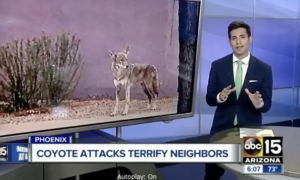Coyotes are in the news a lot in spring and not because camo-clad predator hunters are knocking them for loops out in the wild.
Reports each spring of coyote sightings, coyotes snatching pets and coyotes attacking humans are pretty common. The first two seem to be more common. Folks living in cities expanding into county farmland see coyotes, deer, foxes and other critters fairly regularly. Coyotes attacking folks, though, usually makes headlines like these:
— A man in Wake Forest, North Carolina, was bitten by a coyote while taking out his trash about 9:30 p.m. on April 11.
ABC11.com reported that the man kicked the animal, which continued attacking, before knocking it away with a trash can. The coyote was shot and killed by the man's son. Tests revealed it was positive for rabies. The bitten man was treated for minor injuries.
— A Massachusetts man is lucky to be alive after fighting off a coyote that attacked him Wednesday night. NECN.com reported that Brian Hutchins of Rutland, Massachusetts, was attacked from behind when he went outside his home to tend to chickens about 9 p.m.
"I got jumped from behind. I was terrified," Hutchins told the station. "I grabbed it and pulled it over my head. It was kicking me in the face, the chin, the chest."
— Coyotes are searching for food now to feed pups, and of course this brings out the "A coyote ate my doggie!" stories from homeowners. A newschannel in Phoenix has one such story, with coyotes on the prowl in the sprawling desert city replete with dogs, cats, food for each, trash and other goodies coyotes may spirit away to their dens.
— Law enforcement caught a coyote in a Philadelphia neighborhood. It likely was on the prowl for a cheesesteak sandwich or, failing that, someone's delicious puppy out for a tinkle.

Coyote sightings in an Arizona subdivision are believed to be in part because someone is feeding the animals. Don't do that.
Don't Feed the Coyotes
Well, duh.
This seems like straightforward common sense, but we know there are animal "rights" lovers out there who think it's their mission to feed, protect and save everything. This includes feeding coyotes, even if that means a coyote will snatch a neighbor's dog or cat, or possibly threaten a young child.
From that story about the Phoenix-area coyote situation: Arizona Game and Fish told ABC15 they typically start getting more calls about coyotes around January, and then it peaks in May. They're not surprised about the eight attacks, but they point out, the public should not be feeding the coyotes, it makes them extremely comfortable in your neighborhood.
The Rhode Island Department of Environmental Management had to issue a statement about not feeding coyotes, too: “Coyotes that find abundant and easily obtained food resources around neighborhoods may become bold and habituated to human activity, creating situations that are detrimental to the animal and can also put small pets at risk. Coyote attacks on humans are a rare occurrence, but any coyote that exhibits bold or aggressive behavior to humans should be treated with caution and reported to authorities.”
Again, this should be common sense. Coyotes are not cutesy-wutesy puppy dogs. This idea of putting animals on par with humans is a sickness, but even if feeding coyotes isn't at that level it's just not smart. As the Rhode Island DEM stated, once they become accustomed to vittles around the house then they won't think twice about a cat, dog, chickens, goats, loitering around a kid, or maybe even attacking an adult if they're hungry enough.
What to Do About It?
One story I ran across was about a community in North Carolina, Pine Knoll Shores, and the "growing" problem there.
It seems everywhere in the country the problem is "growing." No one ever wants to say "Dammit, we've had this problem for 20 years. It's not growing. It's already here and getting worse. Let's do something now."
This happens with other things, too, of course. Deer and feral hogs are two that come to mind. Soccer in America has been the "fastest growing sport" for decades (wouldn't it at some point level off?). But I digress. Back to animals.
Coyotes are an issue because they're intelligent, highly adaptable, wary of humans, and therefore they're not commonly seen. Only when they become more acclimated to neighborhoods and start showing up frequently do people believe they have a "growing problem!" when in reality those coyotes likely have been around for a while.
Back in my newspaper days each spring we'd have a reporter, sometimes the summer intern, write about a few people complaining that "coyotes are moving into our neighborhood!" The truth was we moved into their neighborhoods with all the development. The coyotes just adapted.
Trapping and killing them is the dead-level best method to end the problem. Relocating them does nothing but dump a problem elsewhere. Because society has gotten away from trapping and varmint-predator hunting like we had decades ago, these coyote situations have become more common.
Trapping would be a huge help, although city councils don't always have the intestinal fortitude to stand up to the public and do what's right. They do what is politically expedient too many times, or give in to the wailing, clamoring protesting ivory tower dwellers demanding this or that.
Trapping isn't always a possibility in some areas, though, such as Philadelphia or Charlotte. So residents deal with it, the local civic leaders deal with it and life moves on.






